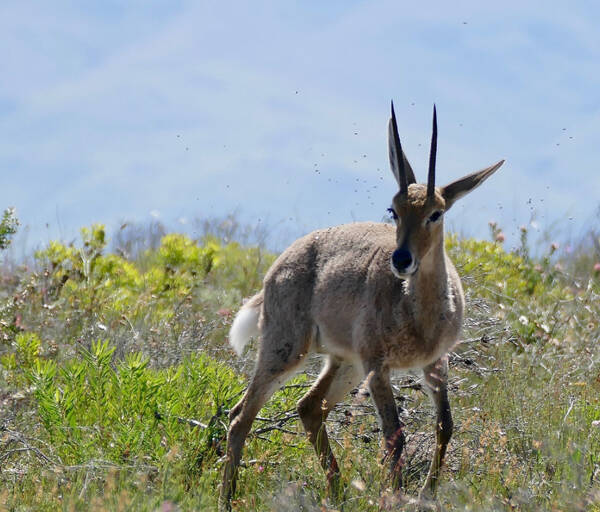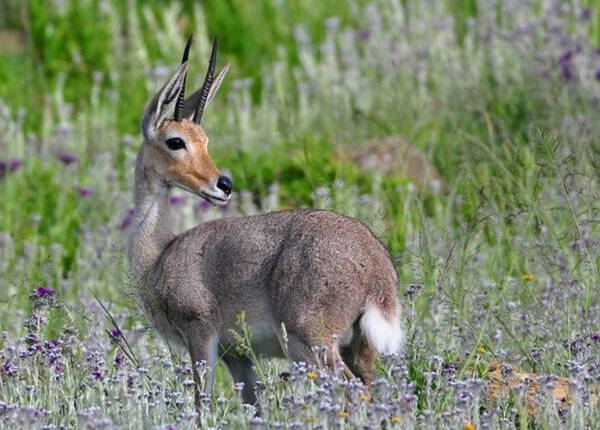Pelea capreolus
IUCN
LCBasic Information
Scientific classification
- name:Pelea capreolus
- Scientific Name:Gray shorthorn, Common shorthorn
- Outline:Ungulata
- Family:Artiodactyla Bovidae Brachyura
Vital signs
- length:115-125CM
- Weight:20-30kg
- lifetime:8-10years
Feature
Only males have horns and males are very aggressive
Distribution and Habitat
The shorthorn is endemic to parts of South Africa, Lesotho, and Swaziland, with a sporadic distribution in areas of suitable habitat. They may occur rarely in southwestern Namibia, but this remains to be verified. Although they are believed to occur in the hilly areas around Gaborone in southeastern Botswana, they are no longer found there. Likewise, although not officially recorded, they once occurred throughout Lesotho as "the only bovid species in reasonable numbers", but as of 2013 may only exist in a few scattered subpopulations.
Habitat is rocky, growing on hillsides and plateaus, venturing into grassy valleys. Young antelopes tend to hide in rocks, caves, or bushes when away from their mothers.
Appearance
The shorthorn is 1.15-1.25 meters long and weighs about 20-30 kg. The body is covered with hair that is more shaggy and curly than all other antelopes, which may be the reason why the shorthorn is often mistaken for a goat. The upper body is brown-grey, the face and legs are yellow, and the lower body and tail are white. The shorthorn can be easily distinguished by its extremely long and erect ears and the absence of bare patches under the ears. The animal's narrow muzzle ends in a small mouth. The forehead is convex, and the eyes with black eyelids stand out very well against the background of the white surround. Only males have horns, which are erect or slightly curved forward and are 200-250 mm in length. The bare area around the nostrils extends to the top of the nose and is swollen. It becomes full of water when the animal is excited. Females have 4 nipples.
Details
Shorthorn (scientific name: Pelea capreolus) Grey Rhebok, Common Rhebok, Rhebok, Vaal Rhebok, no subspecies.

Shorthorn is active during the day, occasionally grazing and resting, and tends to rest in the shade at noon. They form two kinds of social groups. The first consists of many females and one dominant male, usually consisting of about 8 animals, but can be as many as 30. The other social group consists of solitary males who wish to invade a group of females. Fights between territorial males and solitary males are frequent during mating, and it is not uncommon for one of the contestants to be killed.
Typically, a shorthorn is a single male with a group of females, who will defend the group from other intruding males. Methods of defense include posturing, snorting and stamping, and fierce fighting. Males who are unable to win or maintain a territory are usually solitary. Usually, one member of each group acts as a sentinel while the other shorthorns feed or rest. If danger appears, the sentinel will make warning grunts and lead the herd to more rugged terrain. Males are very aggressive and often kill members of the same sex during the rutting season, and even kill and attack sheep and goats.
The short-horned antelope is a herbivorous animal, and weeds are their main food, especially the flowers and leaves of plants. It is basically independent of water and obtains most of its water needs from food.

The mating system of the short-horned antelope is polygamous. Mating occurs in April, when males compete for females. Young are born in November-December, early in the warm, wet season. One calf is born per litter, and young are usually born away from their mothers for the first few months of their lives. Males mature in about 18-21 months, then leave the family group and begin to attempt to establish their own territory. In the wild, life span is 8-10 years.
As of 2014, although the species is not considered threatened due to the lack of access to its habitat, collation of available subpopulation data shows an estimated decline of about 20% over three generations (1999-2014) in the 13 formal protected areas within its range. Most worryingly, one of the largest protected subpopulations, the Maloti-Drakensberg Park World Heritage Site, has seen an estimated decline of 15-20%. Confirming the empirical data are reports of declines or local extinctions of the species in the North West, Western Cape, Northern Cape and Mpumalanga Provinces, and in the Lesotho Highlands. No shorthorned antelope has been recorded in the North West Conservation Area or the "Ohirgstad Dam Nature Reserve" (Mpumalanga Province) since 2013. The species is therefore listed as Near Threatened, within the Prevention Scope, with continued declines due to estimated increased hunting levels, close to Vulnerable A2bd. Further long-term data are needed to improve the accuracy of the species' decline estimates, as it is suspected that subpopulations are also doing poorly outside the protected areas. The species should be reassessed once more reliable data are available, as it may qualify for a more threatened listing. The largest populations of shorthorned antelope are in the World Heritage Sites of Maloti-Drakensberg Park and Golden Gate Highlands National Park, both with subpopulations of more than 400 individuals. The causes of the decline are poorly understood, but may be due to an increase in illegal sport hunting using dogs, bushmeat poaching, incidental trapping, and new threats of increased predation rates. Long-term monitoring sites should be established to quantify subpopulation trends and threat severity.
Listed in the IUCN Red List of Threatened Species in 2016 ver3.1 - Near Threatened (NT).
Protect wildlife and eliminate game.
Maintaining ecological balance is everyone's responsibility!








